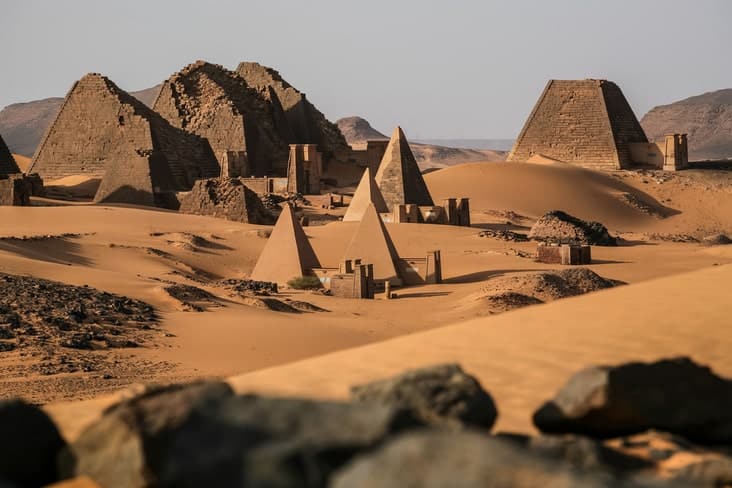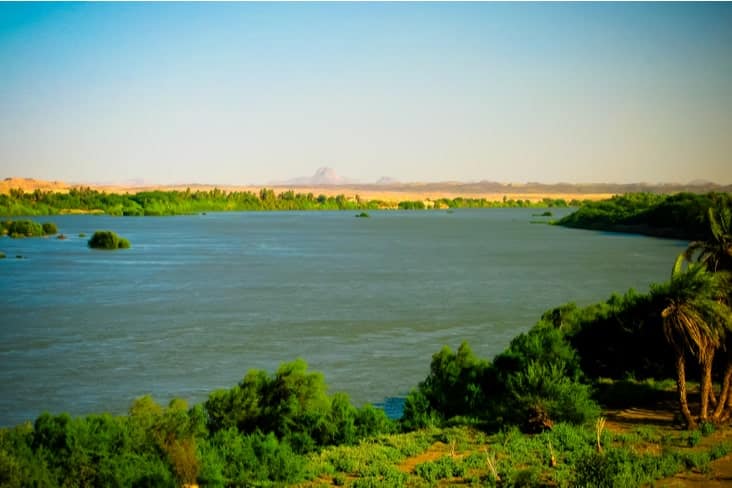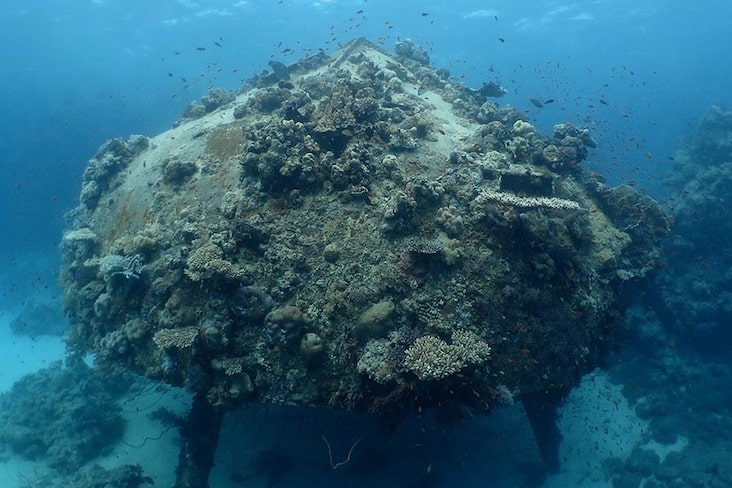Home to the longest river in the world and over 200 pyramids – more than Egypt – these are the most interesting facts about Sudan.

Fast facts
Official name: Republic of Sudan
Population: 46,751,152
Area: 1,861,484 sq km
Capital city: Khartoum
Major languages: Arabic, English, Nubian, Ta Bedawie, Fur
Major religions: Sunni Muslim
Time zone: UTC+2 (Central Africa Time)
– Source: CIA World Fact Book
Interesting facts about Sudan
1. Sudan is a country in Africa bordering the Central African Republic, Chad, Egypt, Eritrea, Ethiopia, Libya and South Sudan.
– Source: CIA World Fact Book
2. With an area that represented over 8% of the African continent and almost 2% of the world’s total land area, Sudan was once Africa’s largest country and the world’s 10th largest. Since South Sudan became independent, Sudan now ranks as Africa’s third-largest country and the world’s 15th.
– Source: Britannica, World Bank
3. The wider area of Sudan, known as Ancient Nubia, has been inhabited since Mesolithic times (Middle Stone Age), around 30,000 to 20,000 BC.
– Source: Britannica

4. Sudan was home to the legendary Kingdom of Kush. Three Kushite kingdoms dominated the region for more than 3,000 years, with capitals in Kerma (2450 – 1450 BC), Napata (1550-1070 BC), and Meroë (300 BC – 300 AD).
Source: National Geographic
5. The name “Sudan” comes from the Arabic “bilad-as-sudan” meaning “land of the black people”.
– Source: CIA World Fact Book
6. From 1899 to 1955, Sudan was part of the Anglo-Egyptian Condominium and under joint British-Egyptian rule.
– Source: Britannica
7. The longest river in the world, The Nile, runs through Sudan. The river’s total length is 6,695km (4,160 miles) and runs from as far away as Burundi and Lake Victoria in East Africa all the way to the Mediterranean in North Africa.
– Source: Guinness World Records

8. In 1956, Sudan gained independence from the UK as the Republic of the Sudan.
– Source: Brittanica
9. Sudan’s capital Khartoum is located where the two main tributaries of the Nile meet: the Blue Nile and White Nile.
– Source: Lonely Planet
10. The name Khartoum likely derives either from the Arabic term “al-jartum” meaning “elephant’s trunk” or “hose,” or from the Dinka words “khar-tuom,” meaning a “place where rivers meet”.
– Source: CIA World Fact Book

11. Sudan fought Africa’s longest-running civil war – the Second Sudanese Civil War. The conflict lasted 22 years from 1983 to 2005, killed at least 1.5 million and displaced over four million people.
– Source: BBC News
12. The 2005 peace agreement led to South Sudan gaining independence in 2011. However, tensions remain and disputes continued over shared oil revenues and border definitions.
– Source: BBC News
13. Sudan’s flag has red, white and black horizontal stripes with a green triangle. Black stands for the name of the country (sudan in Arabic means “black”), white for peace and optimism, red for the struggle for independence and green represents Islam.
– Source: Britannica

14. Sudan has more pyramids than Egypt. The country is home to over 200 pyramids built by the ancient Nubian civilisation from as early as 2500 BC.
– Source: National Geographic
15. One of the most famous cites is the UNESCO-listed Archaeological Sites of the Island of Meroe. In total, the site consists of around 100 pyramids dating from the 8th century BC to the 4th century AD. The site is not actually an island but an area located between the Nile and Atbara rivers.
– Source: UNESCO, Lonely Planet
16. Another famous UNESCO-listed site is the Gebel Barkal and the Sites of the Napatan Region. These five archaeological sites located in the Nile valley, include tombs, pyramids, temples, burial mounds and palaces from the second Kingdom of Kush (around 900 BC to 350 AD).
– Source: UNESCO

17. Sudan is partly covered by the world’s largest hot desert (excluding the Arctic and Antarctic deserts). The Sahara Desert, with a total area of 8,600,000sq km (3,320,000sq mi), covers much of North Africa.
– Source: Britannica
18. Sudan is also partly covered by the Sahel. The Sahel is a narrow transition zone of semi-arid land between the Sahara to the north and the savannas to the south. The Sahel stretches 5,400km (3,300 mi) across Africa, from Senegal to Sudan.
– Source: National Geographic
19. Sudan is one of the countries involved in the ambitious Great Green Wall project – an 8,000km long wall of trees stretching across Africa which will ultimately be the largest living structure on the planet. The trees will traverse 21 African countries along the arid Sahel savanna from the Atlantic Ocean to the Indian Ocean.
– Source: United Nations, CNN
20. The UNESCO-listed Sanganeb Marine National Park and Dungonab Bay – Mukkawar Island Marine National Park is a diverse system of coral reefs, mangroves, seagrass beds, beaches and islets, home to a range of marine life including populations of seabirds, marine mammals, fish, sharks, turtles, manta rays and dugongs.
– Source: UNESCO

21. Sudan’s Dinder National Park is a biosphere reserve of diverse flora and fauna including migratory birds, buffalo, bushbuck, dik-dik, gazelle, giraffe, greater kudu, hartebeest, lion, oribi, ostrich, reedbuck, roan antelope and waterbuck. Black rhinoceros, cheetah, elephant, hyena, jackal and leopard can also be seen in the park.
– Source: UNESCO, Britannica
22. In Eastern Deffufa, an archaeological site in Kerma, archaeologists discovered what is believed to be a royal cemetery with a king’s tomb and the remains of over 30,000 other graves, many of which seem to have been sacrificed to accompany the king to the underworld. Around 5,000 cattle skulls were also unearthed.
– Source: Lonely Planet
23. In 1963, explorer and oceanographer Jacques Cousteau set up the Continental Shelf Station Two (or Conshelf Two), an underwater research centre 10m (33ft) below the surface off the coast of Port Sudan. Five aquanauts lived for 30 days in the undersea base. The venture featured in Cousteau’s 1964 famous documentary film World Without Sun. It is still possible to scuba dive to the remains of the site.
– Source: Smithsonian, Bradt Guides

24. The national symbol of Sudan is the secretary bird. Secretary birds are found in sub-Saharan Africa, stand nearly 1.2m (3.9ft) tall and rarely fly.
– Source: CIA World Fact Book, National Geographic
25. Sudan is the world’s largest exporter of gum Arabic, producing 75-80% of the world’s total output. Gum Arabic is sap from acacia trees and is a vital ingredient used in the production of adhesives, candy, and pharmaceuticals.
– Source: CIA World Fact Book, Britannica
Every effort has been made to verify these facts about Sudan. However, if you find an error or have any questions, please contact us.